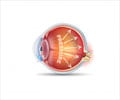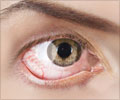Researchers at the University of California, Davis, US, have developed a contact lens with a built-in pressure sensor that could help monitor conditions such as glaucoma.
A novel contact lens with a built-in pressure sensor that could help monitor conditions such as glaucoma has been developed by researchers at the University of California, Davis, US.
The device is based on a new technique, which can embed conducting circuits in the organic polymer traditionally used to make contact lenses.Polydimethylsiloxane (PDMS) is an elastic, transparent and gas-permeable organic polymer that can be cast-moulded into a range simple shapes.
It is widely used in everything from contact lenses to breast implants but the process of cast moulding severely limits the kinds of structures that can be made with the material.
Now, Hailin Cong and Tingrui Pan from the university have come up with a simple method to produce PDMS components without the need for casting moulds and their process can also make the material conduct electricity.
Researchers added a chemical to a liquid PDMS solution that causes the mixture to set, or polymerise, when zapped with UV light.
Then, they exposed the mixture to UV light through a mask containing a circuit pattern.
Advertisement
The technique can be used to create features just 10 micrometers in size.
Advertisement
They did this by adding a solution of silver to the mix. The silver then becomes trapped in the material when it polymerises, creating a path along which electrons can pass.
Since the resistance of the path changes as the material is stretched, the modified PDMS is suitable for a range of microelectromechanical systems.
"This new way of manufacturing PDMS can significantly extend [its] use for biological sensing systems," New Scientist quoted Pan, as saying.
One of the first devices that researchers have produced is a tiny pressure sensor, which they bent into the shape of a contact lens.
Pan said that such a device could measure the stress on the cornea surface, and the fluid pressure within the eye to monitor glaucoma and ocular hypertension.
"The eye always has a certain pressure, which is why the eyeball is a sphere," Pan said.
In glaucoma patients, that pressure rises and changes the shape of the eye, which would deform the contact lens sensor.
"The change in configuration will alter the resistance and give a different electrical reading," Pan said.
Their prototype has an opaque sensor that would impair vision and so would be worn only briefly, but researchers are designing transparent equivalents that could be worn for long periods to give a continuous pressure read-out.
They said that to read the data wirelessly, they would use a tiny RFID tag.
Source-ANI
RAS/K














